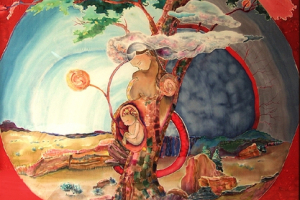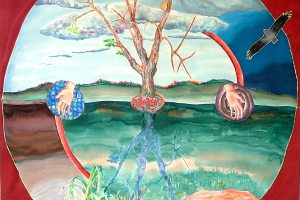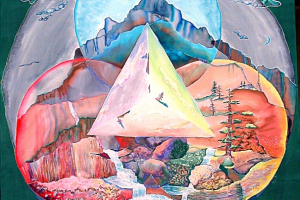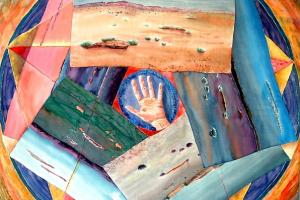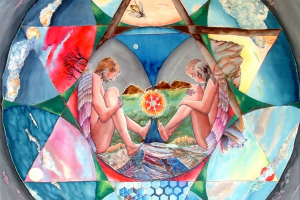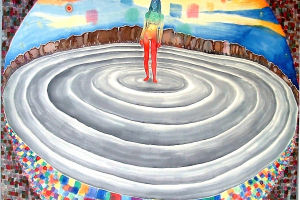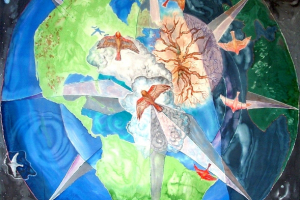In this series of paintings on silk I divide the circle in 1 through 8 parts, and explore geometry and sacred geometry, as well as the associations of numbers 1 through 8 with universal experiences. Here are some notes on these works:
Womb Painting/ Mandala 1
The drawings for this painting began while I was pregnant with my first child. I put the child in the center of a circle, the new “one” emerging from the old “one,” myself. The child in the womb is connected to the whole world he has yet to meet. The sun already powers his brain. His ancestors at the base of the tree form part of the memory of the life-giving tree-mother, whose roots and ranches reach into blood-red. This color has the richest meaning for humans – it gets our attention because we are hard-wired for survival to pay attention to it. In the Indian chakra system, red is the color of the first chakra relating to family origins and tribal identity.
Earth and Sky/Mandala 2
Here is the balance of opposing forces: the earth-bound frog and the sky-bound hawk, each in its element. The frog can jump into the air, but not for long. The hawk can light, but returns to flight. We long for the horizon line to orient ourselves, so we can tell what is near and far. The left hand and right hand controlled by the two opposite brain hemispheres speak to the duality of our bodies, and the ancient idea of balancing yin and yang to maintain spiritual health.
Dichotomies and dualities are among our most common human experiences. The tree in the lower half, a shadow, only exists because of the one in the upper half. Together they make a picture of a single tree.
Mountain/Mandala 3
One of the meanings of a mountain in Chinese traditional painting is that it symbolizes a journey. Beginning at the base of the mountain, we perceive different levels of information as we ascend and our perspective changes. The peak is obscured by clouds because we can’t see the end yet – it the higher level of spiritual awareness.
The three primary colors of yellow, cyan and magenta color the three interior circles, making this painting a kind of color diagram. Coming out from the center of the painting, a pyramid, is the abstracted form of a mountain. Each side is colored with a tinted secondary color (violet/orange/green), reaching toward white.
Water, Fire, Earth, Air/Mandala 4
These four elements have been a traditional way to express all that is in the world. In the four corners of the interior square are circles with their symbols. This painting shows a balance of these elements and hints at the transformation that occurs from one element to the other. The square has log been a symbol of the earth, and the circle a symbol of the heavens. “Circling the square” has several meaning, among them balancing heaven and earth, the spiritual and the corporeal, the divine and the mundane. I refer to an idea from Leonardo Da Vinci in his well-known drawing Vitruvian Man, which relates human proportion to the geometry of the square. The shadowy outline is more androgynous here. Perhaps the figure is protecting the earth.
Another note about Da Vinci: in his understanding of color, there were four primaries – yellow for earth, green for water, blue for air, and red for fire, and he counted black and white as colors, too.
The vanishing point of the deep one-point perspective is the center of the circle. Is the stream flowing toward the center or away from it?
Golden Mean/Mandala 5
This explores the proportion known as the golden mean, mathematically 1: 2.18. It occurs in pentagons and pentagrams, and has cropped up in measurements of ancient human structures like Egyptian pyramids. This pleasing proportion has a long history in our cultural heritage in architecture and art. The landscapes in the painting are “golden mean rectangles,” and the horizon line divides the space again along the golden mean. Each landscape has the same composition but a different time and light.
Another five in this one is the musical fifth, a bright, strong, and stable interval. I though about a combination of colors to express this sound and came up with the contrast of rich gold and indigo-violet. And the five-fingered human hand (a portrait of my painting hand) expresses both receptivity and caution.
Color Wheel/Mandala 6
Since Sir Isaac Newton played with light refraction and recognized a spectrum, he and many other theorists have arranged colors on a circular chart to explain their relationships. The German writer Johann Wolfgang von Goethe, also a color theorist, drew a circle of interlocking equilateral triangles (in 1792) with six points in the sequence red-orange-yellow-green-blue-purple.
Many sixes are referred to here: the six-pointed star, the six circles that fit around one center (try this with pennies – it’s the only way they fit), the six legs of the insect world, the remarkable tessellating hexagonal structure that forms beehives, and hexagonal crystals. The two figures fit inside the vesica pisces formed by overlapping circles. See if you can imagine the rest of the two tangential circles that overlap the central one to create the pointed oval shapes.
The winged figures/angels symbolize male and female elements in balance. This is also, by the way, an interpretation of the six-pointed star symbol. They contemplate the enigma of the burning six-sided snow crystal.
Spectrum/Mandala 7
The seven-stepped spectral sequence identified by Newton, red-orange-yellow-green-blue-indigo-violet, is a way that energy is organized. Long after his first musing on optics, the science of spectroscopy has shown us that every element has a unique spectral “fingerprint” and has allowed us to identify elements on distant planets by reading their color identity. The spectral sequence has been identified with such diverse phenomena as the life-cycle of a star, and the structure of the atom.
The seven steps in the journey of the spirit occurs in many spiritual traditions and corresponds with this sequence. The central figure is colored with a spectrum that indicates the chakras, or energy centers in the body, progressing from red and the base of the spine, to violet at the crown of the skull.
I was also thinking about the ancient Greek goddess Iris, who was identified with the rainbow. Iris, the female counterpart to Mercury, traveled along the rainbow to deliver messages from the Queen of the Gods to man. Walking along this spectral bridge she created a connection between heaven and earth.
This painting has the sound of a gong being struck.
Journey/Mandala 8
Here the journey begins in the center and meanders outward. Our organization of space in eight directions, hence the compass rose, is a linear pattern often at odds with the spiral pattern that may better explain our individual and collective journeys. The image of the earth is taken from satellite photography which is, amazingly, available to anyone on the internet. (This ability to view the planet has to be part of the slow change in human culture toward global thinking.)
The bird changes feathers with each step of the journey, and finally leaves the sphere to join the stars.
